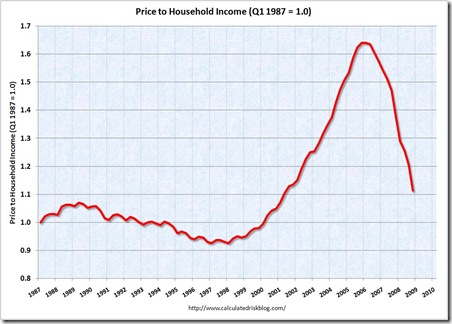One of the impediments to loan modifications is the constraints servicing agreements place on servicers in restructuring loans. If a servicer makes a modification in violation of the servicing agreement, they run the risk the investor may sue them.
Some have argued this risk is not substantial. From Naked Capitalism (my bold):
I've been asserting for some time, based on the comments from mortgage counsellors, that mortgage mods that do not substantially reduce principal balances don't make enough of a difference to the borrower to change outcomes. And with banks and servicers looking at 40%+ losses on many foreclosures, they can reduce principal a lot and still come out ahead.
Mortgage servicers have been experiencing high recidivism rates on loan mods, leading commentators to say that mods don't work. However, it has been reported (Calculated Risk) that many of the so-called mods were payment catch up plans, and not true mods, but the composition of the balance was unclear. Thus it was similarly not certain whether my view was correct.
Some support comes from Wilbur Ross, no soft touch, but a distressed investor (they are not called vultures in polite company). He owns American Home Servicing, the biggest third party servicer in the US. He also offers a program for how to deal with the housing crisis.
Note that American Home Servicing has done a lot of loan mods. Ross makes no mention of the supposed legal obstacles to making mods. That suggests the issue is way overblown (as in investors in theory might sue, but no one is a big enough holder in any one trust for it to be worth the trouble).
The idea that no one is a big enough holder to make litigation worthwhile is wrong; between class action suits and the ripple effect a bad precedent would set, there is plenty for servicers to worry about. And the litigation has already started (including litigation against this particular servicer). Housing Wire reports a hedge fund suing American Home Mortgage Servicing over its REO disposition strategy:
A Greenwich-based hedge fund manager is in a desperate fight to keep his subprime MBS investment strategy alive. HousingWire peeled back the layers to uncover what’s really going on behind the scenes in what has become a vicious battle between the hedge fund and legendary investor Wilbur Ross’ mortgage servicing company, Irving, Tex.-based American Home Mortgage Servicing, Inc.
The lawsuit underscores just how complicated servicing non-agency securitized loans can really be, amid a push by legislators and regulators to put a common set of standards into place to help manage a housing crisis that as of yet shows little signs of slowing down.
Bruce Rose, who runs hedge fund Carrington Investment Partners LP – and who purchased a mortgage servicing platform of his own last year when former subprime high-flier New Century Mortgage went bankrupt – filed a lawsuit last month claiming that American Home Mortgage Servicing, the nation’s largest independent mortgage servicer, had been selling the REO homes it manages at ‘fire sale prices,’ because it needed cash to pay off its warehouse credit facility.
The REO sales push was hurting Rose’s hedge fund, because the loans on the homes are tied to mortgage-backed securities Rose had invested in. According to Carrington investors and sources familiar with Rose’s investment strategy, the hedge fund owns the junior tranches of the deals in question.
American Home is now fighting back. From Housing Wire:
After finding itself dragged into court by hedge fund manager Bruce Rose of Greenwich-based Carrington Capital, Irving, Tex.-based mortgage servicer American Home Mortgage Servicing, Inc. fired its own volley back at both Rose and Carrington on Thursday, suing for alleged acts of racketeering and a scheme to profit illegally from holding REO hostage at the servicing firm. American Home is owned by legendary investor Wilbur Ross’ WL Ross & Co., and is the nation’s largest independent residential mortgage servicer.
The allegations made in the complaint by AHMSI against Rose and Carrington show just how complex relations between servicers and investors can be, amid increasing pressure from lawmakers and regulators to find solutions to the nation’s housing mess.
Servicers are being sued on their modification strategies too. A NYT story on December 1, 2008:
On Monday, a hedge fund sued the Countrywide Financial Corporation, the giant mortgage lender, demanding that Countrywide compensate holders of some securities backed by mortgages if the lender changes the terms of the loans.
The fund, Greenwich Financial Services, said it and other investors stood to lose money if Countrywide, now part of Bank of America, modified loans under a settlement that it reached with 11 state attorneys general in October.
Servicing is a low margin business which only makes money when everything goes smoothly. The downturn has already severely strained servicers; Housing Wire again:
“With the dramatic increase in loan delinquencies come staffing and capacity issues, portfolio risk related to adjustable-rate mortgage resets, and the accompanying pressure to find effective loss mitigation strategies, including loan modifications,” said residential servicer analyst Richard Koch, a director in Standard & Poor’s servicer evaluations group.
“In addition, the spike in foreclosures and real estate owned assets, in our opinion, has stretched the limited number of vendors that service the industry to capacity — and as more loans move through foreclosure into the REO category, the need to make loan advances has placed yet another financial strain on servicers.”
The last thing servicers need is subjecting themselves to the tsuris of litigation with deep pocket investors. Expect them to adhere to their side of the servicing contracts.
![[uhaul.bmp]](https://blogger.googleusercontent.com/img/b/R29vZ2xl/AVvXsEi77j1SxAcJ8gejh4zr92xdf1AhYyB8F9d8w4lBUblBwYPSxM_kmBjEVx0M1eBRL_2VJ8FQv0hFPOyaUhK2Gkm_t85GzsISiX752__TNlZmNHam3gZ4D-WGSy5TuyqpFrcYMYuwcWd0zBQ/s1600/uhaul.bmp)



















